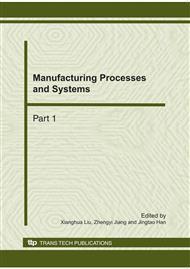p.1375
p.1379
p.1383
p.1390
p.1394
p.1400
p.1404
p.1408
p.1413
Synthesis, Characterization and Properties of Poly (ε-Caprolactone) Glycol Based Casting Polyurethane Elastomers Containing Nano-Size Sio2 Particles
Abstract:
Poly(ε-caprolactone) (PCL) glycol based casting polyurethane elastomers (CPUE) filled with nano-SiO2 particles within different surface properties were synthesized by mean of in-situ polymerization. The macro-static/dynamic mechanical properties and micro-dispersed state were characterized by an electronmechanical universal testing machine, a durometer, a rubber resilience experimental machine, a dynamic-mechanical analyzer (DMA) and a scanning electron microscope (SEM). The tensile modulus at 100% and 300%, elongation at break, tensile strength and tear strength of PCL urethane nanocomposites increased substantially in the presence of a certain amount of nano-SiO2 compared with their pristine state. Furthermore, the tensile strength and tear strength at 100 of the PCL CPUE with 5% nano-SiO2 pretreated by γ-glycidochloropropyl methyl trimethoxy silane (SI-CA) were 1.50 and 1.94 times than those of the pure PCL CPUE, respectively. The addition of the nano-SiO2 had little effect on the hardness, but the impact resilience decreased slightly. DMA analyses showed that the loss factor peaks of two nano-SiO2 polyurethane composites were higher obviously than the pure PCL CPUE and the glass transition temperature (Tg)of the two nano-SiO2 polyurethane composites increased to higher temperature region. SEM fractographs showed that the surface treatment by the optimum silane coupling agent influenced the dispersibility of nano-SiO2 in the PCL CPUE distinctly. The agglomerating phenomenon, and even some nano-agglomerates with more than 1 μm diameter can be observed in the PCL CPUE with 5% untreated nano-SiO2, but the nano-SiO2 pretreated by SI-CA was dispersed in the PCL CPUE in nano-scale.
Info:
Periodical:
Pages:
1394-1399
Citation:
Online since:
October 2010
Authors:
Price:
Сopyright:
© 2011 Trans Tech Publications Ltd. All Rights Reserved
Share:
Citation:


